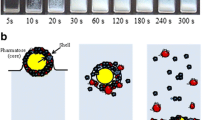Abstract
One of the conventional methods of alleviating the problem of poor drug solubility is the particle size reduction. The efficiency of this approach depends on successful formulation suppressing the drug agglomeration. The aim of this study was to circumvent the dissolution problems of model hydrophobic meloxicam drug (MLX) by using liquid media of different wetting capacity to comminute and formulate a rapidly dissolving carrier system without the use of surfactants. Micro-suspensions of MLX were prepared by ball milling, using water or n-Heptane as a liquid medium. The suspensions were used as granulation liquids to formulate granulate from microcrystalline cellulose and lactose mixture. The release kinetics from prepared granulates were studied using the USP-4 dissolution apparatus. Micro-suspensions prepared via wet milling in non-water liquid media exhibited a massive improvement of release rate compared with source meloxicam and they outperformed their water-milled counterparts. The release rates from those formulations, despite not comprising any surfactant, were comparable to those obtained by different authors using surfactant stabilized nanosuspension formulations. Thus, they can present an interesting formulation alternative for hydrophobic drugs that are dissolution limited.










Similar content being viewed by others

References
Chu KR, Lee E, Jeong SH, Park E-S. Effect of particle size on the dissolution behaviors of poorly water-soluble drugs. Arch Pharm Res. 2012;35(7):1187–95. https://doi.org/10.1007/s12272-012-0709-3.
Savjani KT, Gajjar AK, Savjani JK. Drug solubility: importance and enhancement techniques. ISRN Pharmaceutics. 2012;2012:10–0. https://doi.org/10.5402/2012/195727.
Al-Kassas R, Bansal M, Shaw J. Nanosizing techniques for improving bioavailability of drugs. J Control Release. 2017;260:202–12. https://doi.org/10.1016/j.jconrel.2017.06.003.
Patel VR, Agrawal YK. Nanosuspension: an approach to enhance solubility of drugs. J Adv Pharm Technol Res. 2011;2(2):81–7. https://doi.org/10.4103/2231-4040.82950.
Malamatari M, Taylor KMG, Malamataris S, Douroumis D, Kachrimanis K. Pharmaceutical nanocrystals: production by wet milling and applications. Drug Discov Today. 2018;23(3):534–47. https://doi.org/10.1016/j.drudis.2018.01.016.
Bhakay A, Merwade M, Bilgili E, Dave RN. Novel aspects of wet milling for the production of microsuspensions and nanosuspensions of poorly water-soluble drugs. Drug Dev Ind Pharm. 2011;37(8):963–76. https://doi.org/10.3109/03639045.2010.551775.
Möschwitzer J. Particle size reduction technologies in the pharmaceutical development process. Am Pharm Rev. 2010;2010:54–9.
Rasenack N, Müller BW. Micron-size drug particles: common and novel micronization techniques. Pharm Dev Technol. 2004;9(1):1–13. https://doi.org/10.1081/PDT-120027417.
Wang Y, Zheng Y, Zhang L, Wang Q, Zhang D. Stability of nanosuspensions in drug delivery. J Control Release. 2013;172(3):1126–41. https://doi.org/10.1016/j.jconrel.2013.08.006.
Oliveira ÉFS, Azevedo RCP, Bonfilio R, Oliveira DB, Ribeiro GP, Araújo MB. Dissolution test optimization for Meloxicam in the tablet pharmaceutical form. Braz J Pharm Sci. 2009;45:67–73.
Ambrus R, Kocbek P, Kristl J, Šibanc R, Rajkó R, Szabó-Révész P. Investigation of preparation parameters to improve the dissolution of poorly water-soluble meloxicam. Int J Pharm. 2009;381(2):153–9. https://doi.org/10.1016/j.ijpharm.2009.07.009.
Ochi M, Kawachi T, Toita E, Hashimoto I, Yuminoki K, Onoue S, et al. Development of nanocrystal formulation of meloxicam with improved dissolution and pharmacokinetic behaviors. Int J Pharm. 2014;474(1):151–6. https://doi.org/10.1016/j.ijpharm.2014.08.022.
Liu T, Yao G, Zhang X, Zuo X, Wang L, Yin H, et al. Systematical investigation of different drug nanocrystal technologies to produce fast dissolving meloxicam tablets. AAPS PharmSciTech. 2018;19(2):783–91. https://doi.org/10.1208/s12249-017-0889-8.
Kassem MAA, ElMeshad AN, Fares AR. Enhanced solubility and dissolution rate of lacidipine nanosuspension: formulation via antisolvent sonoprecipitation technique and optimization using Box–Behnken design. AAPS PharmSciTech. 2017;18(4):983–96. https://doi.org/10.1208/s12249-016-0604-1.
Acknowledgments
This work was realized within the Operational Programme Prague Competitiveness (CZ.2.16/3.1.00/24501) and “National Program of Sustainability” (NPU I LO1613 MSMT-43760/2015).
Author information
Authors and Affiliations
Corresponding author
Additional information
Publisher’s Note
Springer Nature remains neutral with regard to jurisdictional claims in published maps and institutional affiliations.
Rights and permissions
About this article
Cite this article
Marinko, N., Zámostný, P. Meloxicam Carrier Systems Having Enhanced Release and Aqueous Wettability Prepared Using Micro-suspensions in Different Liquid Media. AAPS PharmSciTech 21, 155 (2020). https://doi.org/10.1208/s12249-020-01701-4
Received:
Accepted:
Published:
DOI: https://doi.org/10.1208/s12249-020-01701-4



